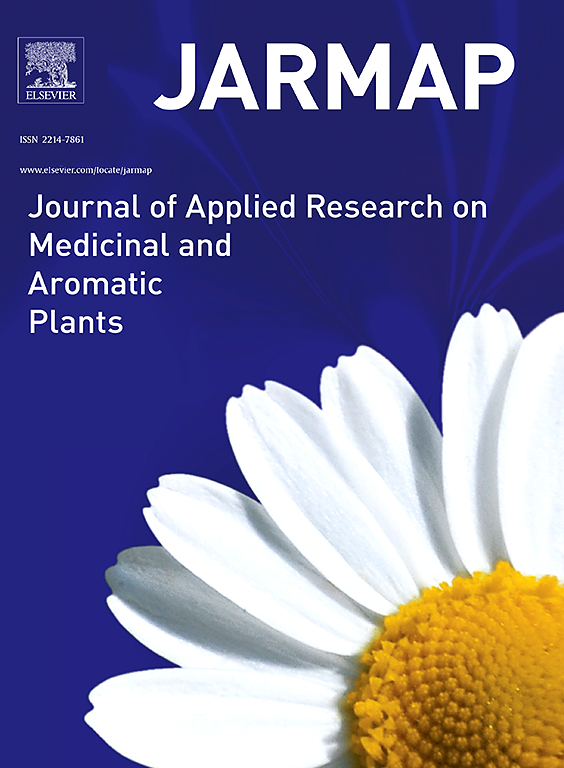Ecology of endomycorrhizal association in black pepper (Piper nigrum L.), South India
IF 3.6
2区 农林科学
Q1 PLANT SCIENCES
Journal of Applied Research on Medicinal and Aromatic Plants
Pub Date : 2024-12-26
DOI:10.1016/j.jarmap.2024.100617
引用次数: 0
Abstract
Arbuscular mycorrhizal fungi (AMF) are crucial root symbionts that play a significant role in nutrient absorption, crop productivity, and soil health. However, it has become essential to understand the ideal environmental conditions that can maximize AMF benefits in crop yield and soil health as a valuable biofertilizer. Accordingly, a comprehensive ecological study of AMF in black pepper (Piper nigrum L.) fields was conducted. The study aimed to identify AMF diversity and population characteristics over a broad area of black pepper fields in Kerala, South India, and to analyse various factors influencing AMF symbiosis in crops. It also focused on identifying the agroclimatic, soil, and crop influencers that impact mycorrhizae in traditional crop fields. Altogether, nine genera and 29 AMF species are identified from the randomly sampled black pepper fields (of diverse varieties of the crop) that belong to two different soil orders and 13 different soil series in the region. Among them, three genera and 22 species were new reports from black pepper. Acaulospora laevis and Funneliformis badius were the most commonly found species. Seasonal analysis showed a significant increase in spore density during the monsoon season, while root colonization exhibited varying patterns. Correlational studies and principal component analysis enabled the identification of specific soil and plant factors individually and in combinations influencing mycorrhizal activities. Overall, the study underscores the significance of ecological research on AMF symbiosis in specific crops and specific soil systems.
南印度黑胡椒(Piper nigrum L.)内生菌根结合生态学
丛枝菌根真菌(AMF)是重要的根系共生体,在养分吸收、作物生产力和土壤健康中起着重要作用。然而,了解理想的环境条件,可以最大限度地提高AMF作为一种有价值的生物肥料在作物产量和土壤健康方面的效益已经变得至关重要。据此,对黑胡椒田AMF进行了全面的生态学研究。该研究旨在确定印度南部喀拉拉邦黑胡椒田AMF的多样性和种群特征,并分析影响AMF在作物中共生的各种因素。它还侧重于确定影响传统作物地里菌根的农业气候、土壤和作物影响因素。从随机抽样的黑胡椒田间(不同品种的作物)共鉴定出9属29种AMF,属于该地区2个不同土壤目和13个不同土壤系列。其中黑胡椒属新报道3属22种。最常发现的种类为laevis Acaulospora laevis和badius funeliformis。季节分析表明,在季风季节孢子密度显著增加,而根定植表现出不同的模式。相关研究和主成分分析能够确定影响菌根活性的具体土壤和植物因素单独和组合。综上所述,本研究强调了AMF在特定作物和特定土壤系统中共生的生态学研究的重要性。
本文章由计算机程序翻译,如有差异,请以英文原文为准。
求助全文
约1分钟内获得全文
求助全文
来源期刊

Journal of Applied Research on Medicinal and Aromatic Plants
Pharmacology, Toxicology and Pharmaceutics-Drug Discovery
CiteScore
6.40
自引率
7.70%
发文量
80
审稿时长
41 days
期刊介绍:
JARMAP is a peer reviewed and multidisciplinary communication platform, covering all aspects of the raw material supply chain of medicinal and aromatic plants. JARMAP aims to improve production of tailor made commodities by addressing the various requirements of manufacturers of herbal medicines, herbal teas, seasoning herbs, food and feed supplements and cosmetics. JARMAP covers research on genetic resources, breeding, wild-collection, domestication, propagation, cultivation, phytopathology and plant protection, mechanization, conservation, processing, quality assurance, analytics and economics. JARMAP publishes reviews, original research articles and short communications related to research.
 求助内容:
求助内容: 应助结果提醒方式:
应助结果提醒方式:


